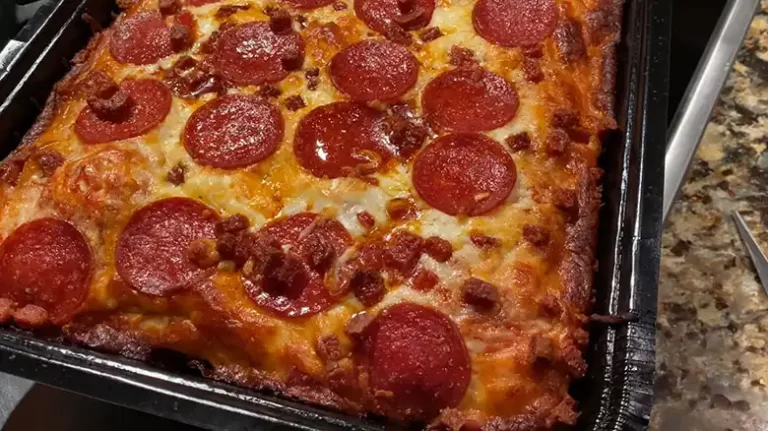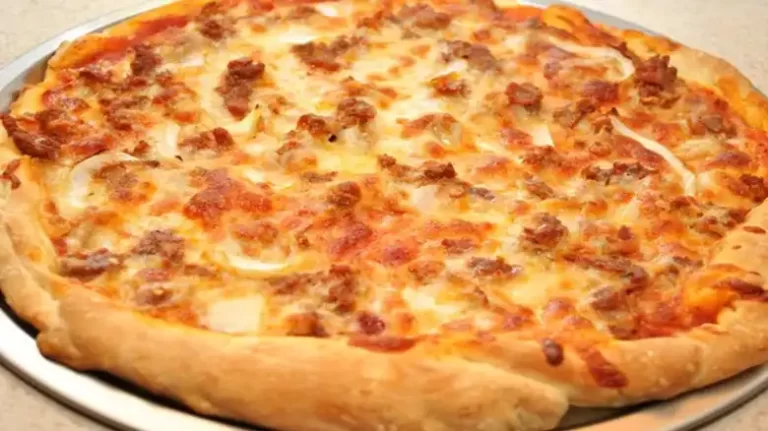How Long to Cook Homemade Pizza at 425 Degrees F
Pizza, a universally beloved dish, is undoubtedly a culinary masterpiece. The satisfaction of biting into a slice of homemade pizza, oozing with melted cheese and adorned with your favorite toppings, is unparalleled.
But to reach this pinnacle of pizza perfection, one must master the art of cooking it to perfection. The fundamental element to consider in this quest is the cooking time, especially when you’re working with the standard temperature of 425 degrees Fahrenheit.
Usually it does not take more than 15-20 minutes to cook the pizza, but then again there are some factors to take into consideration. In this comprehensive guide, we will explore the intricate details of cooking time for homemade pizza at 425°F.

Factors Affecting Cooking Time
Cooking the perfect homemade pizza at 425 degrees Fahrenheit requires more than just setting the timer. Several factors come into play, influencing the time your pizza needs in the oven. Let’s break down these essential factors that determine how long your delicious creation should bake to perfection:
Dough Thickness
The thickness of your pizza crust is a crucial factor in determining its cooking time. Thin crusts tend to cook faster, while thicker ones need more time to ensure they’re cooked through. The choice of thickness depends on your preference for a crispy or doughier crust.
Toppings and Their Moisture Content
The type and quantity of toppings you select can significantly affect the cooking time. Ingredients with high moisture content, such as fresh tomatoes or certain cheeses, may release moisture as they cook, potentially extending the overall baking time.
In contrast, drier toppings like cured meats or well-drained vegetables can lead to a quicker cooking process.
Oven Type
The type of oven you use plays a crucial role in determining cooking time. Whether you’re working with a conventional oven, a convection oven, or even a wood-fired oven, each has its unique characteristics that influence the time required to achieve the perfect pizza.
Understanding your oven’s quirks is key to getting the timing right.
Preparation and Preheating
Before you embark on your homemade pizza-making journey, the first step is to preheat your oven to the standard temperature of 425 degrees Fahrenheit. This might seem like a simple task, but it’s crucial for achieving the perfect pizza.
Preheating serves a dual purpose. Firstly, it ensures that your oven reaches the desired temperature, allowing for even cooking. Secondly, it preps the cooking environment to encourage that delightful crust crispiness.
Selecting the Right Oven Rack
While your oven is preheating, take a moment to consider which oven rack to use. The ideal choice can vary depending on the type of pizza you’re making. For most pizzas, placing the rack in the middle position is a safe bet. This location ensures even heat distribution, resulting in a balanced cook.
Preparing Your Pizza Stone
If you have a pizza stone, it’s a game-changer for achieving that perfectly crisp crust. Place it in the oven as it preheats.
The stone absorbs and radiates heat evenly, contributing to consistent cooking from edge to center. Make sure the stone is in the oven during the entire preheating process to reap its full benefits.
Using a Pizza Peel
A pizza peel is a handy tool for transferring your pizza in and out of the oven. Before you start assembling your pizza, sprinkle a little flour or cornmeal on the peel. This helps prevent the dough from sticking and makes it easier to slide the pizza onto the preheated stone or baking sheet.
Cooking Methods
When it comes to creating the perfect homemade pizza, the method you choose for cooking can make all the difference. In this section, we will explore various cooking methods to help you achieve that ideal pizza at 425 degrees Fahrenheit. Let’s dive into the details:
Conventional Oven
The most common and readily available method for baking homemade pizza is using a conventional oven. To cook your pizza to perfection at 425°F in a conventional oven, follow these steps:
- Preheat your oven to 425°F and allow it to reach the desired temperature.
- Place your pizza on a pizza stone or directly on a baking sheet.
- Slide it into the oven on the middle rack and let it cook for the recommended time, typically between 12 to 15 minutes.
- Keep an eye on your pizza to ensure it doesn’t overcook or burn. Adjust the time as needed.
The conventional oven method offers consistency and ease, making it an excellent choice for most home cooks.
Convection Oven
For those who have a convection oven at their disposal, this cooking method can produce exceptional results. Here’s how to cook your homemade pizza at 425°F using a convection oven:
- Preheat the convection oven to 425°F, and make sure the fan is running.
- Place your pizza on a baking sheet or a pizza stone.
- Put the pizza on the middle rack and set a timer for a slightly shorter cooking time compared to a conventional oven, usually around 10 to 12 minutes.
- The fan in the convection oven ensures even heat distribution, resulting in a crispier crust and well-cooked toppings.
Wood-Fired Oven
For the ultimate pizza experience, cooking your homemade pizza in a wood-fired oven is hard to beat. The intense heat and wood smoke infuse your pizza with a unique flavor. Here’s how you can use a wood-fired oven for the perfect pizza:
- Build a wood fire in your pizza oven and let it burn down to hot coals.
- Push the coals to the side to create an even, intense heat source.
- Place your pizza directly on the oven floor or on a pizza peel for easy transfer.
- With the high temperature in a wood-fired oven, your pizza will cook rapidly, usually in 90 seconds to 2 minutes.
Cooking pizza in a wood-fired oven is an art that requires practice and careful timing, but the results are well worth the effort.
Outdoor Grill
Grilling pizza is another exciting option, especially during the summer months. Here’s how you can cook your pizza at 425°F on an outdoor grill:
- Preheat your grill to 425°F, using indirect heat by turning off the burners under the area where you’ll place the pizza.
- Place your pizza on the grill grates or a pizza stone for even cooking.
- Close the grill lid and cook the pizza for about 10 to 15 minutes, checking regularly to prevent burning.
Grilling your pizza adds a delightful smoky flavor and a slightly charred crust that many pizza enthusiasts adore.
Cast Iron Skillet
Using a cast iron skillet is a unique and efficient method for cooking homemade pizza. Follow these steps for a cast iron skillet pizza at 425°F:
- Preheat your oven to 425°F with the cast iron skillet inside.
- Roll out your pizza dough to fit the skillet’s size.
- Carefully remove the hot skillet from the oven, add a drizzle of oil, and place the dough in it.
- Add your sauce, cheese, and toppings, and then return the skillet to the oven.
- Cook for about 15 to 20 minutes until the crust is golden and the toppings are bubbly.
The cast iron skillet method yields a crispy, golden-brown crust and is ideal for those who want a deep-dish-style pizza.
Brick Oven
If you’re fortunate enough to have access to a brick oven, you can create restaurant-quality pizza at home. Here’s how to cook pizza at 425°F in a brick oven:
- Build a wood fire in the oven and allow it to heat the bricks evenly.
- When the oven reaches 425°F, push the embers to the sides.
- Place your pizza directly on the oven floor or on a pizza peel.
- Cooking in a brick oven typically takes 2 to 4 minutes, so keep a close eye on it.
Cooking pizza in a brick oven delivers a perfect Neapolitan-style crust with a slight char and an enticing smoky flavor.
Checking for Doneness
Once your homemade pizza is in the oven at the standard temperature of 425 degrees Fahrenheit, the anticipation builds. But how do you know when it’s perfectly cooked?
Checking for doneness is the key to achieving that ideal balance of crispy crust, bubbling cheese, and thoroughly cooked toppings. Here are some straightforward methods to determine if your pizza is ready to come out of the oven:
Visual Cues
Keep an eye on the crust; it should turn a lovely shade of golden brown. The edges should be slightly darker, indicating a perfectly crispy texture.
The cheese on your pizza should be bubbling and may have some areas that are lightly browned. This not only looks delicious but also tells you that the cheese is fully melted.
Your pizza’s toppings, whether vegetables, meats, or other ingredients, should look cooked and slightly browned around the edges. They should also appear to be sizzling.
Crust Sound
Listen carefully. When your pizza is nearing perfection, you may hear a subtle crackling sound. This sound signifies that the crust has achieved the desired level of crispness.
Crust Lift
Gently lift the edge of the pizza with a spatula. If it lifts easily and the bottom is uniformly browned, your pizza is ready to be served. The edges should be crisp and the center, while pliable, should not be doughy.
Using a Pizza Thermometer
For those who prefer precision, a pizza thermometer is a valuable tool. Insert it into the center of the pizza. When the temperature reaches a certain degree (typically around 205-210°F), your pizza is perfectly cooked.
This method is particularly useful for deep-dish or stuffed crust pizzas, where the center’s doneness is crucial.
Frequently Asked Questions
Q1: Can I use a different temperature to bake my homemade pizza?
Answer: While 425°F is the standard temperature for baking pizza, you can adjust it based on your preferences. Higher temperatures can result in a quicker, crispier crust, while lower temperatures may be necessary for specific pizza styles. Experiment to find the temperature that suits your taste.
Q2: How long should I preheat the oven to 425°F before placing the pizza inside?
Answer: It’s crucial to preheat your oven for at least 20-30 minutes before baking your pizza. Preheating ensures that the oven and the cooking surface, such as a pizza stone, are at the desired temperature, leading to even cooking.
Q3: What’s the ideal thickness for homemade pizza dough?
Answer: The ideal dough thickness depends on your preference. A thin crust pizza typically has a dough thickness of about 1/8 to 1/4 inch, while a thicker crust may range from 1/2 to 1 inch. Adjust the thickness according to your taste.
Q4: Can I use a pizza stone in a conventional oven for better results?
Answer: Yes, using a pizza stone in a conventional oven can significantly improve the quality of your homemade pizza. A pizza stone helps distribute heat evenly, resulting in a crispier crust. Place the stone in the preheated oven to reap the benefits.
Q5: How can I prevent the center of my pizza from being undercooked?
Answer: To avoid undercooked centers, consider the following tips: reduce the quantity of wet toppings, pre-cook ingredients like chicken or sausage, and make sure your oven is adequately preheated. These measures help ensure even cooking throughout.
Q6: Is there a foolproof method to reheat leftover pizza to maintain its crispness?
Answer: Reheating pizza is best done using an oven or skillet. Avoid using a microwave, as it can make the crust soggy. Heat the pizza at a lower temperature (around 350°F) to maintain its crispness and revive that freshly baked flavor.
Q7: What’s the key to achieving a perfectly cooked pizza at 425°F?
Answer: The key to a perfectly cooked pizza at 425°F lies in balance. Ensure even distribution of toppings, proper preheating of the oven, and careful monitoring of visual cues. Adjust the cooking time based on the thickness of the crust and the moisture content of the toppings.
Q8: Can I use a pizza thermometer for all types of homemade pizza?
Answer: While a pizza thermometer is a helpful tool for deep-dish or stuffed crust pizzas, it may not be necessary for thin-crust varieties. Use it when precise measurement of the center’s temperature is essential for your specific pizza style.
Conclusion
Cooking homemade pizza at 425°F is an art that requires an understanding of various factors, preparation, and patience. With the right combination of ingredients, toppings, and careful monitoring, you can create a pizza that rivals your favorite pizzeria.
Remember, practice makes perfect, so don’t be discouraged by a few trial and error attempts. Armed with this knowledge, you’re well on your way to becoming a pizza-making maestro. So, preheat that oven, roll out that dough, and start crafting your own slice of pizza heaven. Bon appétit!
Meta description: Discover how to cook homemade pizza at 425°F perfectly. Learn about factors, preparation, and checking for doneness in our expert guide.





